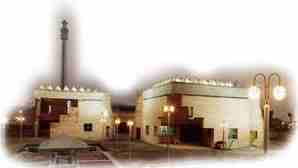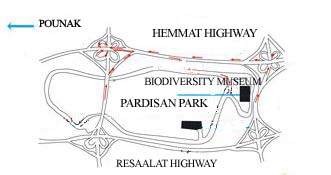
| | You are here : Home > About Us > History
| First Asian Biodiversity Museum Opened in Tehran |

IRNA – Tehran, Wednesday April 14,
President Mohammad Khatami opened Bio-Diversity Museum, today.
Addressing the opening ceremony of the museum, located in a large Eco-park in northwestern Tehran, Khatami pointed to the status of Iran in the list of the world countries with regards to the situation of their life diversity and said though Iran enjoyed a good position in the list, its biodiversity was under grave threats.
He further referred to the geographical status of the country, erosion of soil, population growth and expansion of industrial units as some of the factors posing threats to the life diversity in Iran.
The president of Islamic Republic of Iran described the opening of the museum as an important step towards attracting people's attention to life diversity.
He also stressed that the government has paid more attention to the issue of environment during the third and fourth National Development Plans.
| IRAN National History Museum's History |
The National Museum of Natural History (MMTT) was
founded in 1973 as a part of the DOE. The construction of a
new building covering more than 45,000 m˛ began on World
Museums Day in 1999 with the theme of “The Pleasure of
Discovery” at the Pardisan Park in Tehran.
 Pardisan Eco-Park Pardisan Eco-Park Pardisan (Paradise) Park is a multi-purpose complex covering
more than 270 hectares located in north-west Tehran. This
complex is primarily an educational, research and cultural
center with the objective of creating suitable facilities for the
study of the environment in all its different aspects. However,
in addition to scientific activities, facilities have been created
in Pardisan Park for visitors to spend time in an inspiring,
educational atmosphere. In other words, this Park is a multipurpose project, providing education in fun and relaxed
surroundings aimed at increasing public awareness about natural environment. Pardisan Park contains the Biodiversity
Museum, a wildlife park, a theatre, playgrounds and several other facilities.
| Biodiversity Museum Of IRAN |
In the 1rst step of the implementation of such a project, the Biodiversity Museum of Iran (BMI) has been established and
made open to public visitors. The Museum consist of several parts and sections including:
1- A section demonstrating the Persian Gulf ecosystem,
2- Paleontology part of the Museum which demonstrates different ages,
3- Different divisions containing species from Iran as well as all continents.
The museum also includes several other modern tuition, educational and information systems, such as touch screen
monitors, cyber screen section containing sound effects of different species, information about their habitats and other
related information. It also incorporates several different kinds of educational entertainments for kids and young collegiate.
Side galleries are here to further inform enthusiast visitors.
 Library and scientific document center Library and scientific document center
Due to necessity of an equipped and up-to-date library, the
Natural History Museum of Iran has established a scientific
and educational center in 1984 to:
1- Serve visitors with different kind of books and other
related documents;
2- A reliable internet connection;
3- Balance the level the technical environmental information
with the world of today;
4- Provide necessary facilities in existing resources for
users;
5- Gather actual needs of experts of different fields and to
provide them;  Herbarium of Natural History Museum of Iran Herbarium of Natural History Museum of Iran
Established around 1970, the herbarium of Natural History Museum is one of the major references in the modern and
systematic research on different plants in protected areas. It incorporates a database of information on specimens in more
than 20 fields, generating updated reports on geographic distribution maps.
 Biosafety Laboratory Biosafety Laboratory
As the preservation of genetic diversity is the most important aim of the Department of Environment, and also the Islamic
Republic of Iran is a Party to The Biosafety Protocol under The Convention on Biological Diversity, it is necessary to identify
and conserve the gene pool.
For further achievements in this objective, the Department of Environment has established a Laboratory, in 2001. To further
equip the laboratory, the Natural History Museum of Iran, started to buy the necessary equipments, and incorporated experts
in this field. In march 2003, equipments began to be been installed by experts and professionals in order to:
• Identification of the genetic relationships between species and subspecies,
• Classification of wild life species and subspecies,
• Study and identification of genetic divergence in wild life and the risk of their extinction.
 Green Government Policy Green Government Policy
The Government of the Islamic Republic of Iran adopted a Bill in January 2003 to implement an Environmental Management
System (EMS) for all governmental bodies throughout the country, starting Iranian year 1382 (March 2003).
The Green Government Bill aims at protecting and optimizing the use of resources within governmental bodies. The measure
covers five areas of immediate concern:
• Energy conservation and efficiency,
• Water conservation and recycling,
• Solid waste reduction and recycling,
• Paper conservation and re-use,
• Optimizing government transportation.
As the 1rst step to implement the Green Government Policy in DOE as a pioneer department, the Natural History Museum
once has been accredited ISO-9001 & ISO-14001 international standards.

For more information :
Biodiversity Museum of Iran (BMI)
Pardisan Park,
Hemmat highway,
Tehran, Iran (Islamic Republic of)
Tel: +98 (21) 826 8039
Fax: +98 (21) 883 1297
Web: mmtt.museum.com
|

